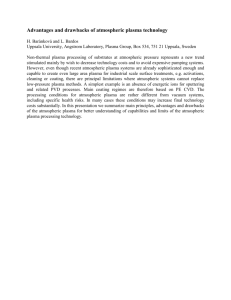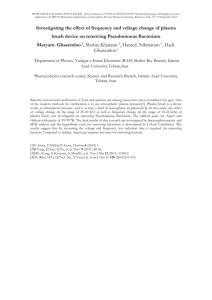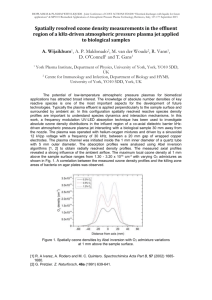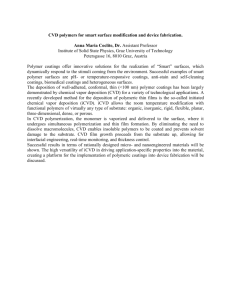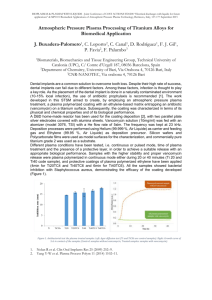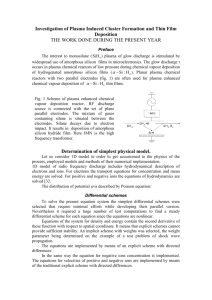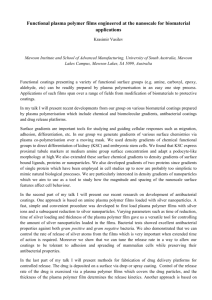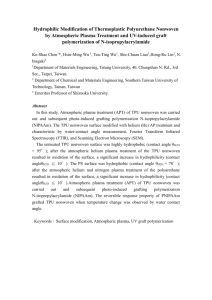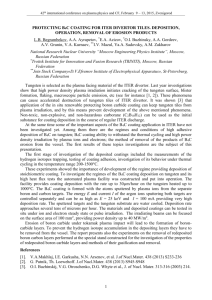Abstract Shelemin - Bioplasmas and Plasmas with Liquids
advertisement
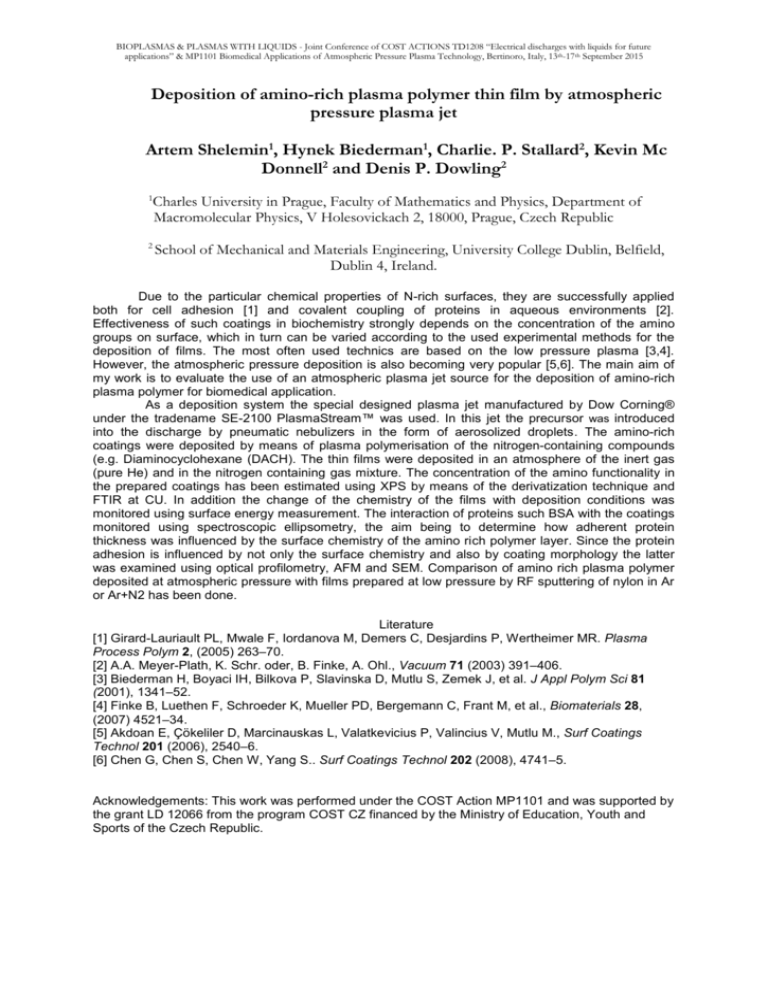
BIOPLASMAS & PLASMAS WITH LIQUIDS - Joint Conference of COST ACTIONS TD1208 “Electrical discharges with liquids for future applications” & MP1101 Biomedical Applications of Atmospheric Pressure Plasma Technology, Bertinoro, Italy, 13th-17th September 2015 Deposition of amino-rich plasma polymer thin film by atmospheric pressure plasma jet Artem Shelemin1, Hynek Biederman1, Charlie. P. Stallard2, Kevin Mc Donnell2 and Denis P. Dowling2 1 Charles University in Prague, Faculty of Mathematics and Physics, Department of Macromolecular Physics, V Holesovickach 2, 18000, Prague, Czech Republic 2 School of Mechanical and Materials Engineering, University College Dublin, Belfield, Dublin 4, Ireland. Due to the particular chemical properties of N-rich surfaces, they are successfully applied both for cell adhesion [1] and covalent coupling of proteins in aqueous environments [2]. Effectiveness of such coatings in biochemistry strongly depends on the concentration of the amino groups on surface, which in turn can be varied according to the used experimental methods for the deposition of films. The most often used technics are based on the low pressure plasma [3,4]. However, the atmospheric pressure deposition is also becoming very popular [5,6]. The main aim of my work is to evaluate the use of an atmospheric plasma jet source for the deposition of amino-rich plasma polymer for biomedical application. As a deposition system the special designed plasma jet manufactured by Dow Corning® under the tradename SE-2100 PlasmaStream™ was used. In this jet the precursor was introduced into the discharge by pneumatic nebulizers in the form of aerosolized droplets. The amino-rich coatings were deposited by means of plasma polymerisation of the nitrogen-containing compounds (e.g. Diaminocyclohexane (DACH). The thin films were deposited in an atmosphere of the inert gas (pure He) and in the nitrogen containing gas mixture. The concentration of the amino functionality in the prepared coatings has been estimated using XPS by means of the derivatization technique and FTIR at CU. In addition the change of the chemistry of the films with deposition conditions was monitored using surface energy measurement. The interaction of proteins such BSA with the coatings monitored using spectroscopic ellipsometry, the aim being to determine how adherent protein thickness was influenced by the surface chemistry of the amino rich polymer layer. Since the protein adhesion is influenced by not only the surface chemistry and also by coating morphology the latter was examined using optical profilometry, AFM and SEM. Comparison of amino rich plasma polymer deposited at atmospheric pressure with films prepared at low pressure by RF sputtering of nylon in Ar or Ar+N2 has been done. Literature [1] Girard-Lauriault PL, Mwale F, Iordanova M, Demers C, Desjardins P, Wertheimer MR. Plasma Process Polym 2, (2005) 263–70. [2] A.A. Meyer-Plath, K. Schr. oder, B. Finke, A. Ohl., Vacuum 71 (2003) 391–406. [3] Biederman H, Boyaci IH, Bilkova P, Slavinska D, Mutlu S, Zemek J, et al. J Appl Polym Sci 81 (2001), 1341–52. [4] Finke B, Luethen F, Schroeder K, Mueller PD, Bergemann C, Frant M, et al., Biomaterials 28, (2007) 4521–34. [5] Akdoan E, Çökeliler D, Marcinauskas L, Valatkevicius P, Valincius V, Mutlu M., Surf Coatings Technol 201 (2006), 2540–6. [6] Chen G, Chen S, Chen W, Yang S.. Surf Coatings Technol 202 (2008), 4741–5. Acknowledgements: This work was performed under the COST Action MP1101 and was supported by the grant LD 12066 from the program COST CZ financed by the Ministry of Education, Youth and Sports of the Czech Republic. BIOPLASMAS & PLASMAS WITH LIQUIDS - Joint Conference of COST ACTIONS TD1208 “Electrical discharges with liquids for future applications” & MP1101 Biomedical Applications of Atmospheric Pressure Plasma Technology, Bertinoro, Italy, 13th-17th September 2015
